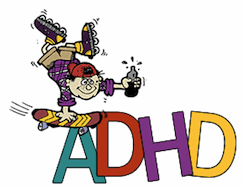3 Types of ADHD: What Nannies Should Know
January 29, 2012 | in Nannies
 Before becoming a nanny for a child diagnosed with Attention Deficit Hyperactivity Disorder, or ADHD, the average person is typically unaware that there are actually three different types of the disorder. The Center for Disease Control recognizes Predominately Inattentive Type, Predominantly Hyperactive-Impulsive Type and Combined Type as the three types of ADHD. Because a child’s behavioral and academic success depends largely on receiving treatment and interventions tailored to their individual needs, it’s imperative that parents, educators and nannies understand the specific traits of each variation. Predominantly Inattentive Type ADHD Children with Predominantly Inattentive Type Attention Deficit Hyperactivity Disorder exhibit symptoms that are largely related to their attention span. These kids will have significant difficulty seeing a task through to completion, following instructions, maintaining a lengthy conversation or focusing on details. Because they are easily distracted, children suffering from Predominantly Inattentive Type ADHD may even have trouble remembering detailed instructions relating to their daily routines. Time management and keeping track of personal belongings are typically problem areas, along with maintaining order and organization. Predominantly Hyperactive-Impulsive Type ADHD A child with Predominantly Hyperactive-Impulsive Type ADHD has difficulty sitting still and keeping quiet, often appearing to have endless reserves of energy. Younger kids with Predominantly Hyperactive-Impulsive ADHD typically run, climb, jump and engage in other physical activity almost constantly, giving parents and nannies quite the strenuous workout. In addition to their boundless physical energy, these kids also have severe impulse-control problems, causing them to interrupt others during conversations, abruptly snatch objects out of others’ hands, speak at inappropriate times and struggle with taking turns and following directions. Because of the combined impulse-control problems and physical hyperactivity, kids with Predominantly Hyperactive-Impulsive ADHD may also seem accident-prone and sustain more injuries than their non-ADHD peers. Adolescents, teens and young adults with this type of ADHD will often express their hyperactivity by fidgeting, pacing, tapping their fingers and jiggling their legs excessively. Children and adults alike will struggle with waiting in long lines, and will often blurt out inappropriate or unkind thoughts, as they lack the impulse control to keep these thoughts to themselves. Combined Type ADHD Unsurprisingly,
Before becoming a nanny for a child diagnosed with Attention Deficit Hyperactivity Disorder, or ADHD, the average person is typically unaware that there are actually three different types of the disorder. The Center for Disease Control recognizes Predominately Inattentive Type, Predominantly Hyperactive-Impulsive Type and Combined Type as the three types of ADHD. Because a child’s behavioral and academic success depends largely on receiving treatment and interventions tailored to their individual needs, it’s imperative that parents, educators and nannies understand the specific traits of each variation. Predominantly Inattentive Type ADHD Children with Predominantly Inattentive Type Attention Deficit Hyperactivity Disorder exhibit symptoms that are largely related to their attention span. These kids will have significant difficulty seeing a task through to completion, following instructions, maintaining a lengthy conversation or focusing on details. Because they are easily distracted, children suffering from Predominantly Inattentive Type ADHD may even have trouble remembering detailed instructions relating to their daily routines. Time management and keeping track of personal belongings are typically problem areas, along with maintaining order and organization. Predominantly Hyperactive-Impulsive Type ADHD A child with Predominantly Hyperactive-Impulsive Type ADHD has difficulty sitting still and keeping quiet, often appearing to have endless reserves of energy. Younger kids with Predominantly Hyperactive-Impulsive ADHD typically run, climb, jump and engage in other physical activity almost constantly, giving parents and nannies quite the strenuous workout. In addition to their boundless physical energy, these kids also have severe impulse-control problems, causing them to interrupt others during conversations, abruptly snatch objects out of others’ hands, speak at inappropriate times and struggle with taking turns and following directions. Because of the combined impulse-control problems and physical hyperactivity, kids with Predominantly Hyperactive-Impulsive ADHD may also seem accident-prone and sustain more injuries than their non-ADHD peers. Adolescents, teens and young adults with this type of ADHD will often express their hyperactivity by fidgeting, pacing, tapping their fingers and jiggling their legs excessively. Children and adults alike will struggle with waiting in long lines, and will often blurt out inappropriate or unkind thoughts, as they lack the impulse control to keep these thoughts to themselves. Combined Type ADHD Unsurprisingly,
children with Combined Type ADHD exhibit both inattentive and hyperactive-impulsive attention deficit hyperactivity disorder symptoms in any combination. Distractibility, impulsivity, disorganization and physical hyperactivity can exist simultaneously, or in a variety of combinations. The Diagnostic and Statistical Manual, commonly known as the DSM, states that the majority of children and adolescents with ADHD have the combined type, though insufficient data exists to make the same claim for adult sufferers of ADHD. There is still no known cause of ADHD, though the CDC suggests that recent studies of identical twins linked genetic material with a predisposition for the disorder. None of the current studies have supported theories that excessive sugar intake, television or social factors cause ADHD, though environmental factors can exacerbate symptoms in some children with a prior diagnosis. The majority of children with ADHD are receiving both pharmaceutical and behavior therapy to minimize and control symptoms, with varying degrees of success. The most effective treatment plan includes frequent follow-ups and monitoring by a physician and a therapist. Nannies who work with children who have ADHD have a real opportunity to make a difference. By partnering with parents to ensure that a child’s treatment plan is fully executed, they can help a child reach his fullest potential.
← 10 Reasons to Start a Nanny Support Group | 10 Challenges Nannies Face During a Recession →Comments are closed.
Search for nanny jobs
in your zipcode:






